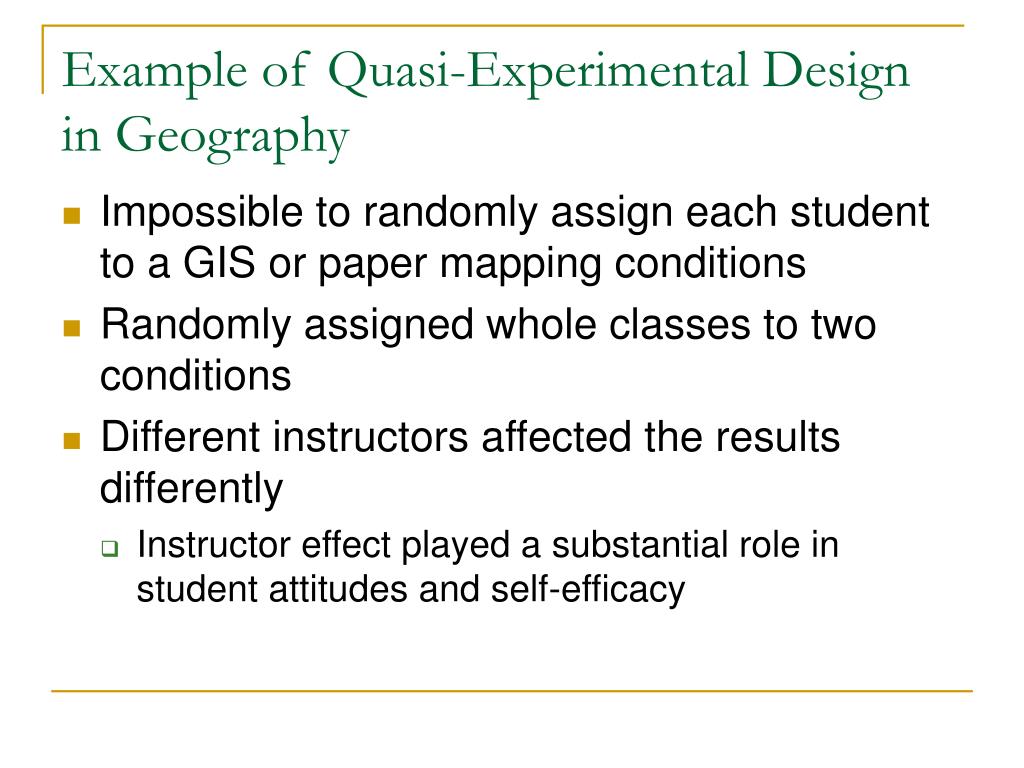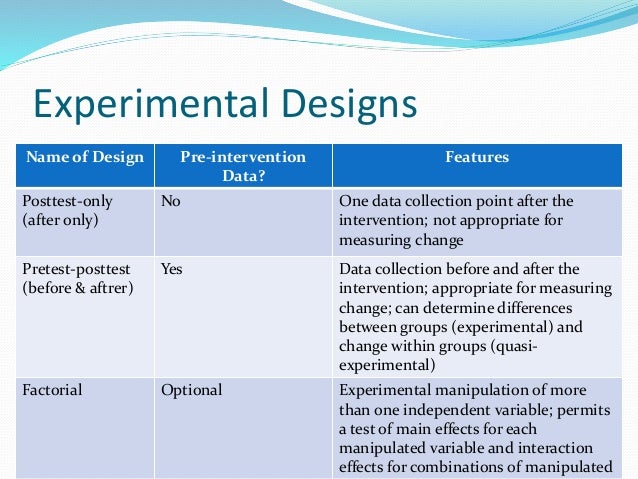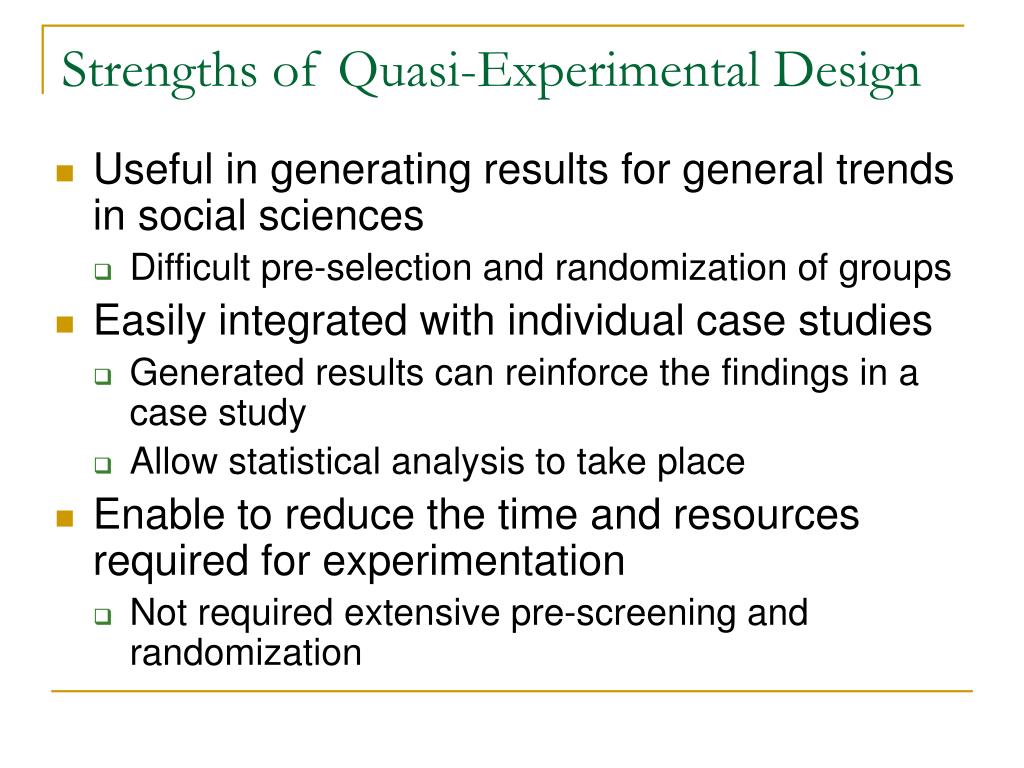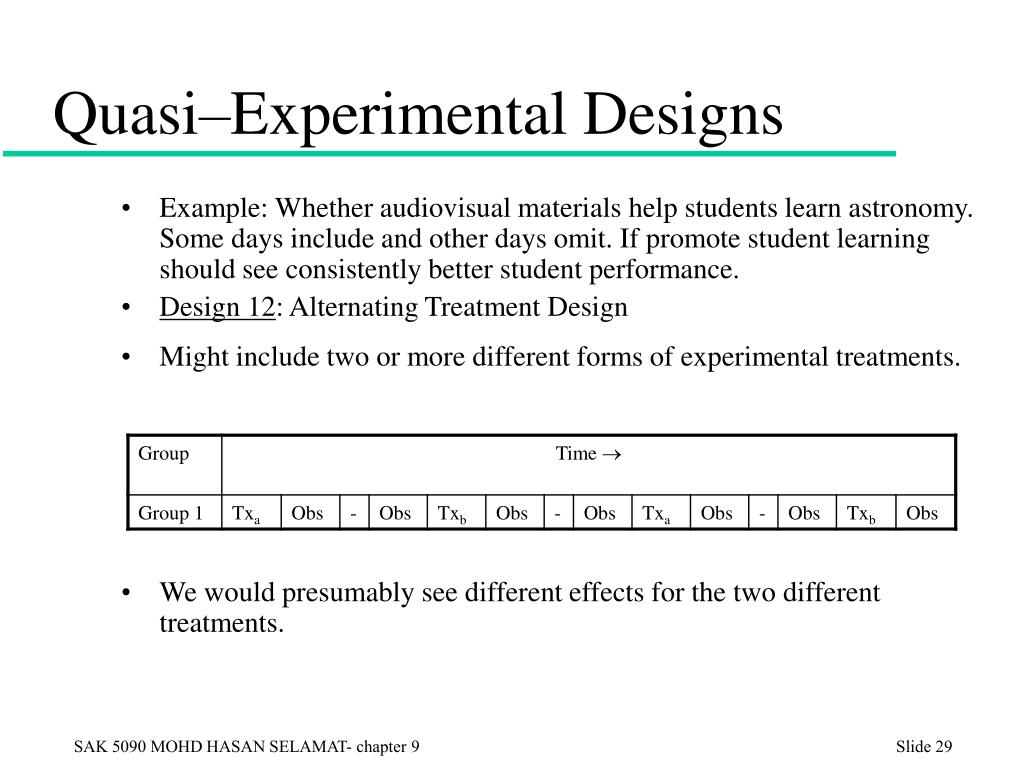Table Of Content
- Selecting and Improving Quasi-Experimental Designs in Effectiveness and Implementation Research
- Characterize fidelity and measures of implementation processes
- Differences Between Quasi-Experiments And True Experiments
- BROWSE BY CATEGORY
- 1. Pre-Post with Non-Equivalent Control Group
- Differences between quasi-experiments and true experiments
- Interrupted Time Series

The dependent variable is the number of student absences per week in a research methods course. The treatment is that the instructor begins publicly taking attendance each day so that students know that the instructor is aware of who is present and who is absent. There is a consistently high number of absences before the treatment, and there is an immediate and sustained drop in absences after the treatment. This figure also illustrates an advantage of the interrupted time-series design over a simpler pretest-posttest design. If there had been only one measurement of absences before the treatment at Week 7 and one afterward at Week 8, then it would have looked as though the treatment were responsible for the reduction. The multiple measurements both before and after the treatment suggest that the reduction between Weeks 7 and 8 is nothing more than normal week-to-week variation.
Selecting and Improving Quasi-Experimental Designs in Effectiveness and Implementation Research
One caveat is that if the intervention is thought to have persistent effects, then O4 needs to be measured after these effects are likely to have disappeared. In addition, there are often ethical issues in this design in terms of removing an intervention that may be providing benefit. A single pretest measurement is taken (O1), an intervention (X) is implemented, and a posttest measurement is taken (O2).
Characterize fidelity and measures of implementation processes
Below, we describe features of each QED, considering strengths and limitations and providing examples of their use. While both quasi-experimental designs and true experiments aim to uncover cause-and-effect relationships, they differ in terms of control over variables, randomization, and ethical considerations. Understanding these differences is crucial for researchers when selecting the most appropriate research method for their study. As we mentioned before, quasi-experimental research entails manipulating an independent variable by randomly assigning people to conditions or sequences of conditions.
Differences Between Quasi-Experiments And True Experiments

Think of quasi-experimental design as a clever way scientists investigate cause and effect without the strict rules of a lab. Instead of assigning subjects randomly, researchers work with what they’ve got, making it more practical for real-world situations. Another problem with quasi-experiments is the natural progression of the disease or the condition under study — When studying the effect of an intervention over time, one should consider natural changes because these can be mistaken with changes in outcome that are caused by the intervention. Because the assignments are not random, it is harder to draw conclusions about cause and effect than in a real experiment. However, quasi-experimental designs are still useful when randomization is not possible or ethical. “Resemblance” is the definition of “quasi.” Individuals are not randomly allocated to conditions or orders of conditions, even though the regression analysis is changed.
BROWSE BY CATEGORY
Thus, if the average length of stay did not change following the intervention but pharmacy costs did, then the data are more convincing than if just pharmacy costs were measured. Quasi-experimental research designs play a vital role in scientific inquiry by allowing researchers to investigate cause-and-effect relationships in real-world settings. These designs offer practical and ethical alternatives to true experiments, making them valuable tools in various fields of study. With their versatility and applicability, quasi-experimental designs continue to contribute to our understanding of complex phenomena. In a true experiment investigating the effects of a new medication on a specific condition, researchers would randomly assign participants to either the experimental group, which receives the medication, or the control group, which receives a placebo. In a quasi-experiment, researchers might instead compare patients who voluntarily choose to take the medication to those who do not, examining the differences in outcomes between the two groups.
1. Pre-Post with Non-Equivalent Control Group
For example, O1 could be pharmacy costs prior to the intervention, X could be the introduction of a pharmacy order-entry system, and O2 could be the pharmacy costs following the intervention. Including a pretest provides some information about what the pharmacy costs would have been had the intervention not occurred. Patients undergoing the new procedure are compared with similar patients who received conventional treatment in the past. Although not randomly assigned, comparing outcomes between the two groups provides valuable insights into the procedure’s effectiveness. Researchers assess participants’ weight and fitness levels before and after the program implementation. While participants weren’t randomly assigned, the program’s impact on health outcomes can still be evaluated.
Differences between quasi-experiments and true experiments
Imagine a study aiming to determine the effectiveness of math apps in supplementing traditional math classes in a school. Randomly assigning students to different groups might be impractical or disrupt the existing classroom structure. Instead, researchers can select two comparable classes, one receiving the math app intervention and the other continuing with traditional teaching methods.
Interrupted Time Series

For both experimental and quasi-experimental designs, we will discuss a recent implementation study as an illustrative example of one approach. Researchers assessed the program's effectiveness by assigning the selected subjects to a randomly assigned treatment group, while those that didn't win the lottery were considered the control group. This research design is common in laboratory and field experiments where researchers control target subjects by assigning them to different groups. Researchers randomly assign subjects to a treatment group using nature or an external event or situation.
The effect of access to electronic resources during examination on medical and dental students scores in summative ... - BMC Medical Education
The effect of access to electronic resources during examination on medical and dental students scores in summative ....
Posted: Mon, 12 Dec 2022 08:00:00 GMT [source]
Implicit in this approach is the assumption that the greater the similarity between groups, the smaller the likelihood that confounding will threaten inferences of causality of effect for the intervention (33, 47). Thus, it is important to select this group or multiple groups with as much specificity as possible. Public health practice involves implementation or adaptation of evidence-based interventions into new settings in order to improve health for individuals and populations. Such interventions typically include on one or more of the “7 Ps” (programs, practices, principles, procedures, products, pills, and policies) (9). Increasingly, both public health and clinical research have sought to generate practice-based evidence on a wide range of interventions, which in turn has led to a greater focus on intervention research designs that can be applied in real-world settings (2, 8, 9, 20, 25, 26, 10, 2). With random assignment, study participants have the same chance of being assigned to the intervention group or the comparison group.
The authors conducted statistical analyses to compare differences in outcomes between program participants and non-participants. Accident data is collected over several months before and after the regulation’s implementation. By analyzing trends in accident frequency, researchers can assess whether the intervention had a significant impact. Quasi-experimental research compares groups with different circumstances or treatments to find cause-and-effect links. Suppose, for example, a group of researchers was interested in the causes of maternal employment.
These designs are becoming increasingly popular in clinical treatment (Bhatt and Mehta, 2016) but could also hold promise for implementation scientists, especially as interest grows in rapid-cycle testing of implementation strategies or efforts. Adaptive designs could potentially be incorporated into both SMART designs and stepped wedge studies, as well as traditional RCTs to further advance implementation science (Cheung et al., 2015). Ideally, these and other innovations will provide researchers with increasingly robust and useful methodologies for answering timely implementation science questions. The pre-post with non-equivalent control group uses a control group in the absence of randomization. Ideally, the control group is chosen to be as similar to the intervention group as possible (e.g. by matching on factors such as clinic type, patient population, geographic region, etc.).
Key research questions in implementation science often involve determining which implementation strategies to provide, to whom, and when, to achieve optimal implementation success. As such, trials designed to evaluate comparative effectiveness, or to optimize provision of different types or intensities of implementation strategies, may be more appealing than traditional effectiveness trials. The methods described in this section are not unique to implementation science, but their application in the context of implementation trials may be particularly useful for informing implementation strategies. This kind of experiment would raise ethical concerns since the participants assigned to the treatment group are required to eat junk food against their will throughout the experiment. For instance, it's impractical to trawl through large sample sizes of participants without using a particular attribute to guide your data collection.
By leveraging innovative designs like regression discontinuity and natural experiments, researchers can navigate the complexities of real-world scenarios while generating meaningful insights. As we continue to explore the boundaries of research methodology, platforms like Voxco provide essential tools and support for conducting and analyzing, driving advancements in knowledge and understanding. The directionality problem is avoided in quasi-experimental research since the regression analysis is altered before the multiple regression is assessed. However, because individuals are not randomized at random, there are likely to be additional disparities across conditions in quasi-experimental research. This will include discussion of ways that implementation-focused RCTs may differ from efficacy- or effectiveness-oriented RCTs. This will include discussion of the strengths and weaknesses of these types of approaches in answering implementation research questions.
In a pretest-posttest design, the dependent variable is measured once before the treatment is implemented and once after it is implemented. Imagine, for example, a researcher who is interested in the effectiveness of an antidrug education program on elementary school students’ attitudes toward illegal drugs. The researcher could measure the attitudes of students at a particular elementary school during one week, implement the antidrug program during the next week, and finally, measure their attitudes again the following week. The pretest-posttest design is much like a within-subjects experiment in which each participant is tested first under the control condition and then under the treatment condition.















